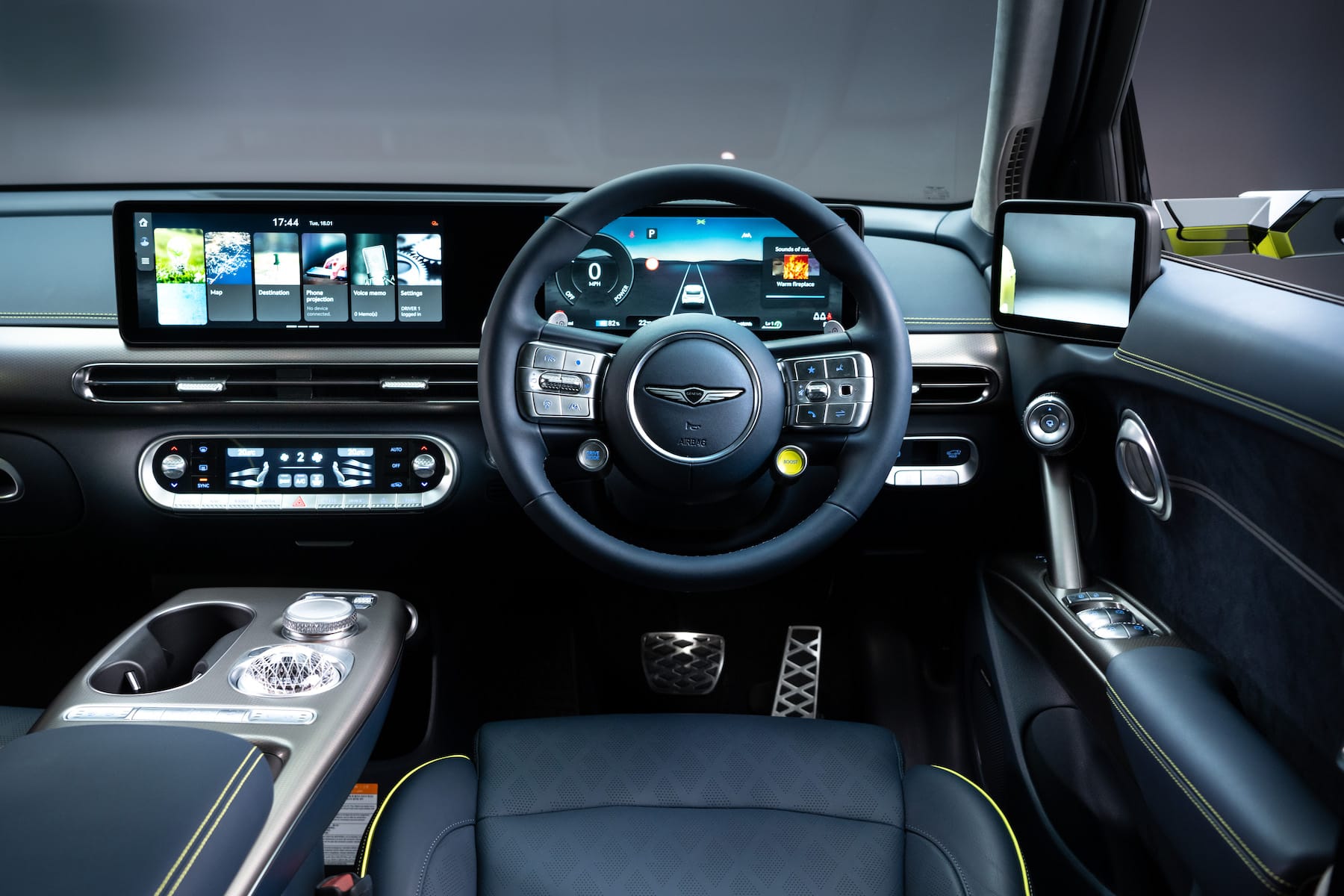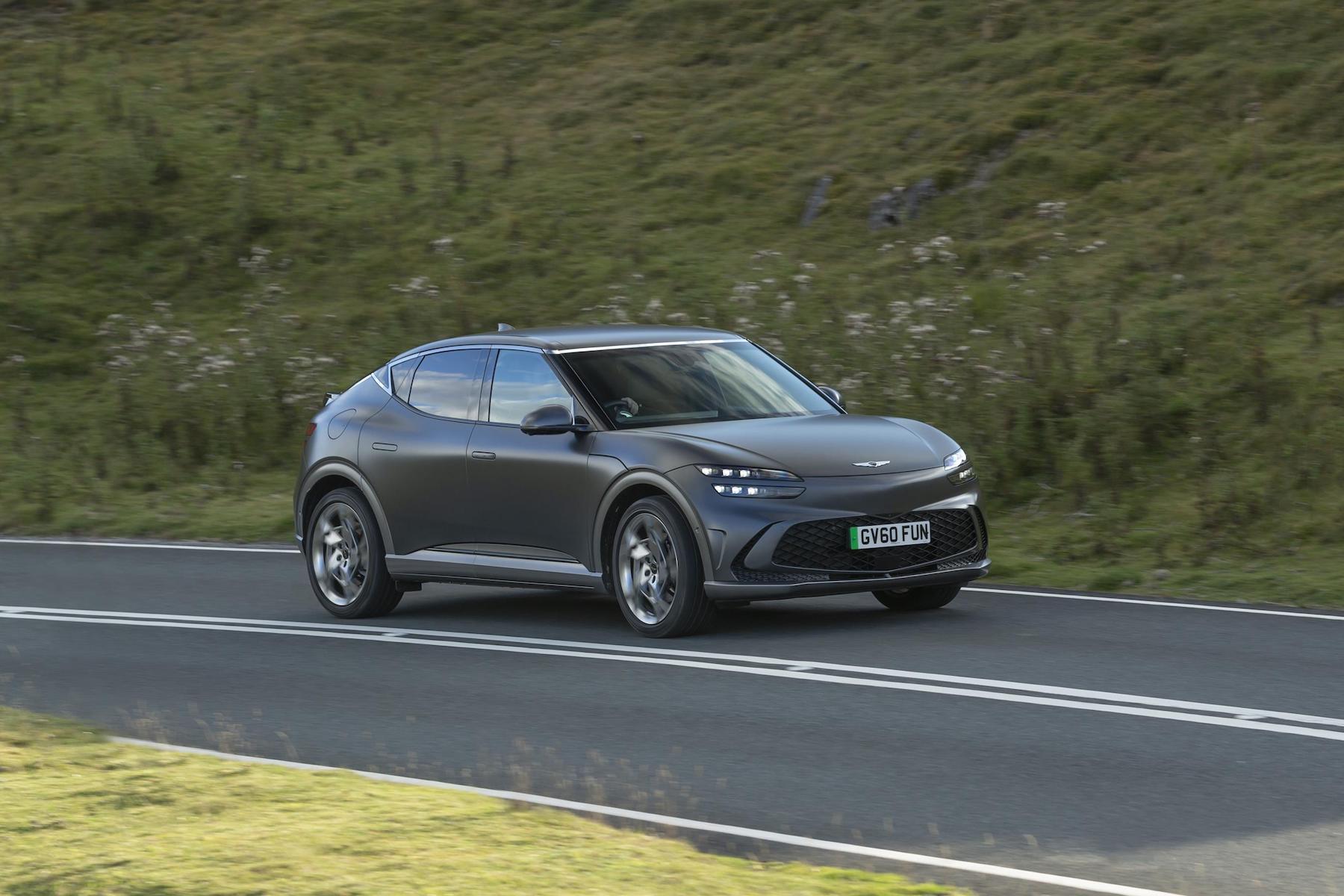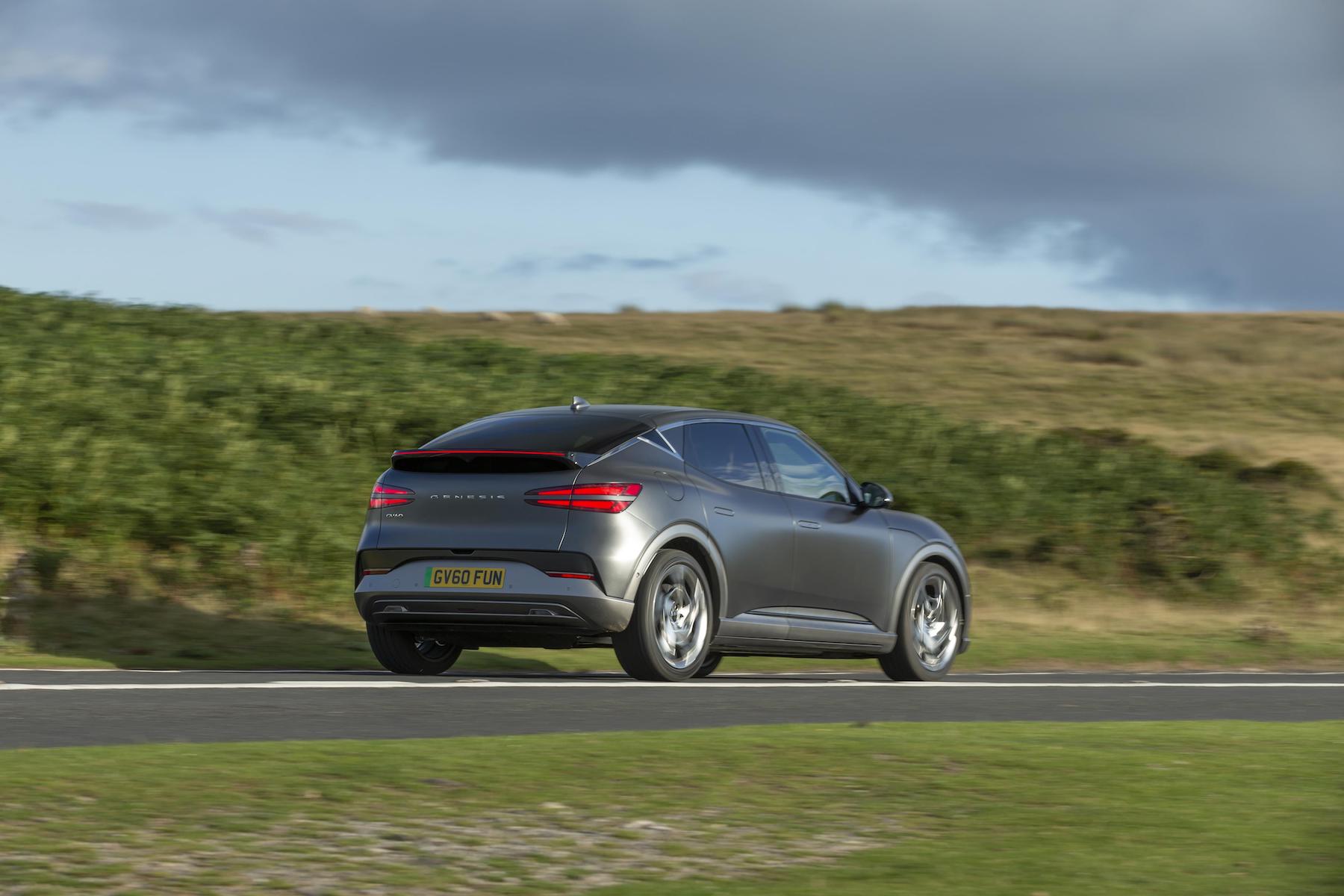Make and model: Genesis GV60 168kW RWD Premium
Description: Mid-sized SUV, electric
Price range: £53,905 (plus options)
Genesis says: “Setting a new standard for luxury electric car design”
We say: You might not have heard of Genesis, but you should certainly have a look at the GV60 if you’re in the market for an electric car from other premium brands
Introduction
This week we’re driving the new Genesis GV60, which is the star of the Genesis show. It’s the company’s first dedicated electric car (rather than converting an existing petrol vehicle to electric power, which it has done with the GV70 SUV and G80 saloon).
If you’re still catching up on exactly who or what Genesis is, then we have a handy cheat-sheet here. But basically it’s the new premium brand from the Hyundai Group, which sits above Hyundai and Kia in the family and is aimed at existing premium car brands like Audi/BMW/Mercedes.
The GV60 is the car that’s really putting Genesis on the new car map in the UK. It’s the first Genesis model designed specifically for Europe rather than for America, and that very much shows in almost every aspect of how the car looks and drives.
What is it?
The Genesis GV60 is a mid-sized electric hatchback, which competes against premium electric rivals like the BMW i4, Polestar 2 and Tesla Model 3. It also has to compete for customers with hybrid alternatives like the Mercedes-Benz C-Class or BMW 3 Series.
It’s built on the same platform as the excellent EVs from Genesis’ sister companies within the Hyundai group – the Hyundai Ioniq 5 and Ioniq 6, and the Kia EV6 – but offers its own distinct style and set of features.
The GV60 went on sale in 2022, and has already received a few tech updates earlier this year. It’s available in three different versions, with either one electric motor (driving the rear wheels) or two motors (one for the front wheels and one for the rear wheels).

Who is this car aimed at?
Genesis is to Hyundai as Lexus is to Toyota or Audi is to Volkswagen. So the GV60 is aimed at customers looking for a premium label and experience rather than a mainstream name from the same overall company.
The company puts a lot of focus on its customer experience, with its customer-facing staff acting more like a hotel concierge than a car salesperson. With most cars on the market being perfectly decent vehicles, Genesis is aiming to make everything else around buying and maintaining your car as effortless as possible.
Genesis is also one of the first car companies to embrace car subscriptions. This is still a niche means of funding a new car, but is growing in popularity and other car brands are starting to pile in.
So if you can afford a nice new car but you’re time-poor and/or don’t want the hassle of managing a car, Genesis can take all of that drama off your hands so you can simply get on with your life.
Who won’t like it?
Anyone who prefers the security blanket of a familiar German badge, or believes that the Koreans can’t do luxury cars. They’re wrong, but they’re never likely to find out for themselves or believe anyone that tells them otherwise.
First impressions
Bring a press vehicle, we didn’t get to experience the famed ‘Genesis Difference’ customer experience that actual buyers get, with the designer-label showroom ambience and your own concierge to arrange collection and return of your car when it’s due for a service, or to help otherwise manage the various boring aspects of owning a car. We had a very nice bloke who dropped the car off but that’s about it…
If you’re ever wondering how to spot a car that’s been designed from the ground up as an EV, rather than a car that was originally designed as a petrol car but is also available with electric power, the Genesis GV60 offers a textbook example.
Looking from the side, the wheelbase (the bit of the car between the front and rear wheels) is quite long, while the overhangs (the bits ahead of the front wheels and behind the rear wheels) are quite short. This is because most of the big, heavy electric components – the motor, the battery and other bits – are mounted between the front and rear wheels, so there’s less stuff to hang out the front or out the back.
At the front, an electric motor is far more compact than a petrol or diesel engine, so everything is packaged up more neatly. Similarly at the rear, there’s no exhaust and no fuel tank to squeeze in so there’s less metal around and behind the rear wheels.
The GV60 isn’t really a tall SUV, but it’s also not really a low-down conventional hatchback – it’s kind of a halfway house, which is also becoming very standard for electric cars. This is because you’re sitting on top of the battery pack, which runs along the floor, so you’re sitting slightly taller than in a normal car but a bit lower than in most SUVs.
Styling-wise, the GV60 is very en vogue for an EV, with no gawping front grille that makes many petrol cars (such as other Genesis models) look like hungry whales. But is it really any more than just a ‘Taste the Difference’ Kia EV6? Let’s find out.
What do you get for your money?
Once we’ve got the first impressions out of the way, it’s time to look a bit harder at exactly what you’re getting for your money with the Genesis GV60.
The range starts with the ‘Premium’ model, which has a single 168kW (230hp) electric motor driving the rear wheels – this is the model we’re reviewing here. Pricing starts at about £54K.
Middle of the range is the ‘Sport’, which adds a second electric motor for the front wheels to provide all-wheel drive, and offers a total of 234kW (320hp) between the two motors. This adds an extra £4.5K, bringing you to about £58.4K.
Top of the tree is the Sports Plus, also all-wheel drive but with a substantially higher total power output of 320kW (460hp), which can be boosted up to 360kW (490hp) for ten seconds – you know, for those special occasions when 460hp just isn’t enough. Pricing also jumps substantially, starting at £67.5K.
Official driving range from the 77kWh battery is about 320 miles for the single-motor Premium model, and about 290 miles for the all-wheel drive models. The batteries can take a 350kW ultra-rapid charge (if you can find one in the UK), which would allow you to charge from 10% to 80% in less than 20 minutes. On a more common 50kW charger, you’re looking at about 1 hr 15 mins for the same charge.
Equipment levels are pretty decent on all models. Premium and Sport models get leatherette trim for the seats rather than actual cowhide, while top-spec Sport Plus offers soft Nappa leather (a £2,300 option on the lower models). You get 19-inch wheels on the Premium and 20-inch wheels on the Sport, while the Sport Plus gets 21-inch wheels and more advanced suspension.
New for the GV60 in 2023 is a bit of new tech called Face Connect. It’s a facial recognition system activated by a camera built into the B-pillar (the pillar behind the front door) that recognises your face, unlocks the car and allows you to drive away – without even having the key present. It sounds convenient and clever, but in our experience it worked about half the time, which is not good enough for you to be confident in leaving home without the car key. Speaking of keys, you can also use your phone as a digital car key, and share the code with four other people to allow them to unlock and drive away in your car.
We like: Decent equipment levels on all models, and all the key safety kit is standard as well
We don’t like: Top-spec model looks a bit pricey compared to the other two. Face Connect not reliable.


What’s the Genesis GV60 like inside?
Like many EVs, there’s more room inside the Genesis GV60 than you’d expect by looking at the car – although boot space is better described as adequate than enormous.
The driving position is nice and, as mentioned earlier, you sit bit higher than in a regular saloon or estate. The view out the rear window is pretty limited due to a rear wing and the shape of the rear window. Our car had conventional wing mirrors, but you can optionally replace those with cameras and internal screens.
The seats have massaging abilities that range from mild to intense, with the idea being that it helps maintain circulation on longer journeys. We didn’t have any long journeys over the week to see whather they did reduce that numb-bum feeling, but in normal everyday driving the sensation wasn’t particularly enjoyable.
As is the case with a lot of new cars, the Genesis GV60 has two screens mounted side-by-side across the top of the dashboard – one for the driver’s instruments and information, and one for infotainment. There are a lot of settings you can play with here, and the manual isn’t especially helpful in guiding you through the myriad of menus and functions. Even after a week with the GV60, we hadn’t explored all of them in detail.
A good example of this is the in-cabin sound effects. You can choose from three different sounds for the car to play to replace the lack of traditional engine noise. So if you want your GV60 to sound like a spaceship, or a racing car, or to play some general sort of humming sound, you can. You can also adjust the volume and intensity of the sound. Or, as I did and most owners will probably do, turn the sound effects off altogether and enjoy the silent running that only an EV offers.
If you like the idea of delving deep into your car’s settings to get everything absolutely perfect, then you’ll love the personalisation available on the GV60. You can also save your settings to your individual driver profile, coded to your fingerprint so that everything is configured for you when you start the car. But if you just want to get in and drive without having to take lessons in how the operating system works, it’s not that intuitive.
One function that may come in useful is the ability to maneuvre the car forwards or backwards using the key as a remote control. It’s designed to help you get the car in or out of a tight parking spot but, over the course of our week with the GV60, it was far more useful at entertaining a six-year-old child every time we went out to the car…
We like: Substantial personalisation available for each driver
We don’t like: Learning curve can be daunting and user manual isn’t particularly helpful
What’s the Genesis GV60 like to drive?
Lke most EVs, the GV60 can be as simple as you like to drive – get in, select D for drive, and away you go. Accelerate, brake, steer. Easy.
If you want more involvement, various settings and controls can come into play. Evo, Comfort and Sport may as well be described as slow, medium and fast, with the only noticeable difference being the response when you put your foot down.
Like most EVs, the GV60 allows you to adjust the amount of regeneration you get. If you’re an EV novice, that means you can adjust how quickly the car slows down when you lift off the accelerator pedal. You can let it coast like a normal petrol car, or you can set it to slow down more quickly (it feels like the brakes are being applied lightly), which returns more electricity to the battery. You can even drive it as a one-pedal vehicle a lot of the time (so it feels like you’re hitting the brakes just by lifting off the accelerator), without having to touch the brake pedal much at all.
The GV60 allows you to adjust these settings from paddles behind the steering wheel, much like the gearshift paddles on sporty petrol cars. This works well, and you can easily adjust how much braking effect you want by clicking the paddles for more or less braking effect – much like downshifting to increase your engine braking on a petrol car when going down a hill. Depending on your driving conditions, you can eke out a few extra miles from every charge by adjusting the braking effect to suit the conditions.
Despite the trim names Sport and Sport Plus, Genesis focuses more on luxury than performance. Most of the time, that sums up the GV60 driving experience well enough, as it’s a car that prefers a motorway to a twisty B-road. The ride on the Premium model is reasonable enough, although potholed roads still jar more than you’d like for a car that claims to be luxury-oriented.
Straight-line performance from the Premium model is plenty for most poeple. These days, 230hp (although EVs tend to use metric power figures, which is 168kW) isn’t a whole lot, although with EVs that power arrives instantly, rather than having to rev up to it as you do in a fossil-fuel car. It means a decent shove in the back when you put your foot down, but nothing overwhelming and it fades reasonably quickly if you keep accelerating. We have driven the Sport Plus version, which has twice the power, separately and it has a far more Tesla-like explosion of acceleration when you prod the accelerator pedal.
Regardless of acceleration, it’s not a memorable driving experience – but then, most customers aren’t looking for that. Being rear-wheel drive is certainly nicer than front-wheel drive when the weather’s good, although a front-drive car is easier to handle when the roads get icy in winter.
We like: Gearshift paddles allow to you precisely adjust the engine braking/regeneration levels from corner to corner
We don’t like: Not as enjoyable to drive as a similarly priced BMW i4


How safe is the Genesis GV60?
Safety-wise, it’s all good news for the GV60. It was tested by Euro NCAP in September 2022 and awarded a five-star Euro NCAP safety rating with very good scores in every category. These scores cover adult protection, child production, vulnerable road user protection (basically minimising damage to pedestrians and cyclists in an accident) and, probably most importantly, the tech that helps you avoid an accident in the first place.
Importantly, every model gets all the safety kit, rather than key items being shoved onto the options list. Top marks to Genesis for that from us.
Charging the Genesis GV60
If you’re charging the single-motor GV60 from a wallbox at home, Genesis says that it will take about seven-and-a-half hours to charge the battery from 10% to full. So even if you are driving a couple of hundred miles every day, you can still comfortably charge overnight and be good to go again next day. In reality, the average household does about 100 miles a week, so its not a problem.
If you’re out and about and charging from a public charging station, the GV60 can take up to 350kW of rapid charging, which can get you from 10% to 80% of battery charge (equivalent to about 200 miles of charge) in 18 minutes. You won’t find a car that can charge much faster than that, although you’ll struggle to find a charging point that can deliver charge that quickly.
At a 50kW charging point, which is more common for public charging locations, charging up from 10% to 80% should take 73 minutes.
So long journeys are certainly manageable with a little planning – and this will only get better over time as more rapid charging points are installed all over the country.
The GV60 comes with two cables; a Type 2 cable for wallbox or public charging, and a Type 3 cable for connecting the car to a regular three-pin plug (although that would take more than a day to charge the battery). Both cables are about 5m long, which is about average. The charging point is on the right-hand side of the car, behind the rear wheel, which is a similar location to the petrol filler on many cars.
An optional extra on the GV60 is a V2L (vehicle-to-load) pack. This is a an adaptor that allows you to use the car’s battery to power electrical devices, like an outdoor fridge or light if you’re camping. It might be convenient if you do a lot of outdoorsy stuff, but it’s pricey at nearly £900.
To make paying for your electricity more convenient (although no cheaper), Genesis is rolling out an integrated Europe-wide charging payment system. That means you can charge your car at many public charging points without the need for dozens of different mobile apps or payment cards. We haven’t tried this, so can’t vouch for its effectiveness, but if it works well then it takes a significant hassle out of public charging.
Verdict
We drove the Genesis GV60 for a week immediately after driving the Nissan Ariya for a week, and the differences in the nature of the two vehicles (which were very similarly priced) was revealing.
We often hear that electric cars are ‘all the same’ and that they lack the individual character of a petrol car. Most of that is anti-EV nonsense, from people who have probably never driven an electric car for more than 15 minutes, but there’s no doubting that EVs are fundamentally alike in how they deliver their power. So it was surprising to feel such a noticeable difference between the GV60 and the Ariya.
The GV60 definitely feels like it has more layers to it, that you work your way through over time. A lot of that comes from the configuration settings. The Ariya feels more plug-and-play, and there are far fewer settings to play with. Which you prefer will depend on how much you tend to engage with your car – I loved fiddling with the various settings, whereas my other half thought it was all a bit unnecessary and overblown.
The rear-drive GV60 was also more enjoyable to drive, although still not as engaging as an old-school petrol car with a manual gearbox (not that many of those still exist on the new car market anymore).
Back to a question I posed earlier: Is it more than just a tarted-up Kia EV6 or Hyundai Ioniq 5? Yes and no. The driving experience isn’t significantly different, but the interior and overall character of the car do feel different – certainly moreso than the difference between an Audi Q4 e-tron and the Volkswagen ID.4, which is a very similar comparison as those two vehicles are basically the same car as well. And it’s better than either of those German EVs.
Similar cars
Audi Q4 e-tron | BMW iX3 | Citroën ë-C4 X | Ford Mustang Mach-E | Hyundai Ioniq 5 | Hyundai Kona Electric | Kia EV6 | Mercedes-Benz EQA | Nissan Ariya | Polestar 2 | Skoda Enyaq iV | Subaru Solterra | Tesla Model Y | Toyota bZ4X | Volkswagen ID.4 | Volkswagen ID.5 | Volvo XC40 Recharge
Key specifications
Models tested: Genesis GV60 168 RWD Single Motor Premium
Price (as tested): £61,115 (including £7,210 of options)
Engine: single electric motor
Gearbox: Single-speed automatic
Power: 168 kW / 230 hp
Torque: 350 Nm
Top speed: 115 mph
0-60 mph: 7.8 seconds
Electric range: 321 miles
CO2 emissions: 0 g/km
Euro NCAP safety rating: Five stars (Sept 2022)
TCE Expert Rating: 77% (as of Sep 2023)
Buy a Genesis GV60
If you’re looking to buy a new or used Genesis GV60, The Car Expert’s partners can help you find the right car.
Discover great deals available on both new and used cars. Find out more

Search for your next new or used car with Auto Trader. Find out more
Lease a Genesis GV60
If you’re looking to lease a new Genesis GV60, The Car Expert’s partners can help you find a competitive deal
Subscribe to a Genesis GV60
Subscriptions are becoming a very popular way for consumers to try an electric car for a few weeks or months to help decide whether it’s a suitable alternative to a petrol car. If you’re interested in a car subscription, The Car Expert’s partners can help. (PS: What’s a car subscription?)





